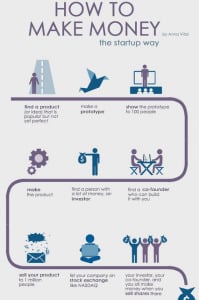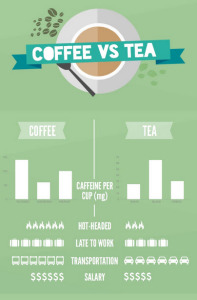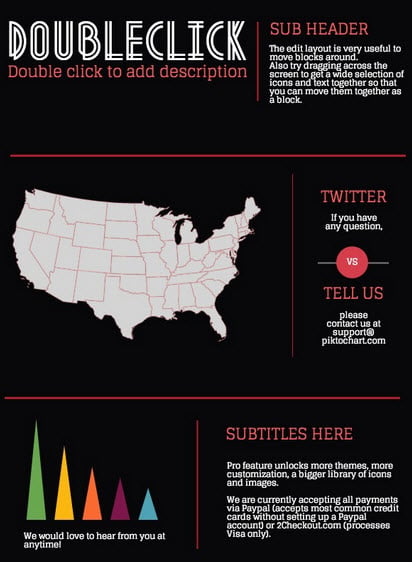

Piktochart makes creating infographics and visuals easy — and it’s free! There are so many ways to add it to class, too. (Public domain image via Pixabay)
We live in an increasingly visual world.
I first really noticed it in USA Today. I always loved those infographics in the bottom corner of the front page. I might not read any articles or open any other sections, but I always read the infographics.
Billboards. Magazine ads. Banner ads on websites. They’re all laden with visuals. And we always seem to look at them.
Unfortunately, our classroom activities seldom reflect the stunning qualities of these visuals. We’re often stuck with white pages with black text. Even the “Grey Lady” — the New York Times, named for its pages of black and white — even allows color visuals on its pages today!
Piktochart is a great web app that allows students to create products that other students will actually WANT to read. It lets students combine visuals, text and interactive web elements into a dynamic, eye-catching presentation.
It’s free (of course!). It’s powerful. It has tons of options. And the products created by it can be shared in many formats.
So why not jump in and give it a shot? Here are 20 ways Piktochart can be incorporated into the classroom:
1. Research papers — They’re a staple of so many classes and are often the worst offenders of the “black and white” assignments. If the goal is information and writing skills, why not apply both of those to a graphic instead of pages of text that nobody will want to read?
2. Posters — These are classroom staples, too. But posters created on Piktochart have a much larger reach than poster board. Each Piktochart can be accessed online with a link, embedded on a website, or turned into a picture file to be attached anywhere online.
3. Character profile — So many subject areas study the lives of people. The interesting facts, photos and details of their lives can be added to one of Piktochart’s pre-designed templates or designed on a blank canvas for submission as an assignment.
4. Class survey — Students have opinions on everything. Surveys incorporate human relations skills, math and analysis. Ask them anything and report the results in a stunning way.
5. Infographics — These were the draw to USA Today I mentioned earlier. Wonderful, fun, informative infographics are all over social media. Piktochart has icons and customizable data charts that can spice up any set of data.
 6. Describe a step-by-step process — Demonstration is a necessary part of life. Use a graphical layout of the steps necessary to do anything, from making a peanut butter and jelly sandwich to using a complex tool online. Users will find the directions they need in an easy-to-digest format.
6. Describe a step-by-step process — Demonstration is a necessary part of life. Use a graphical layout of the steps necessary to do anything, from making a peanut butter and jelly sandwich to using a complex tool online. Users will find the directions they need in an easy-to-digest format.
7. Agendas — Everyone has a schedule to follow, and history is full of timelines. Showing the chronological order of events, whether in the future or in the past, makes for easier remembering.
8. Compare and contrast — Any classroom does this on a regular basis. Lists of similarities and differences help us make sense of new material by comparing it to what we already know. Comparing and contrasting on a well organized page with visuals makes a powerful learning experience.
9. Ad or promotional campaign — Robert Louis Stevenson said, “Everyone lives by selling something.” Ideas, products, even causes can be promoted. Students can use Piktochart to create a modern campaign to promote something (and demonstrating what they know about it along the way).
10. Visual storytelling — Who doesn’t love reading a graphic novel or comic book? My daughter has read almost every (maybe every?) “Diary of a Wimpy Kid” book. Why? They’re fun, and they combine graphics and text well. Another use of Piktochart!
 11. Slideshow graphics — PowerPoint presentations can be dull without interesting slides. Create fantastic graphics for your presentations using Piktochart’s icons and charts.
11. Slideshow graphics — PowerPoint presentations can be dull without interesting slides. Create fantastic graphics for your presentations using Piktochart’s icons and charts.
12. Do’s and don’ts list — This one can also fit about any content area. Every subject has things you should do and you shouldn’t do. These Piktocharts can be created by students as an assignment OR by teachers for their students.
13. Organizational chart — Showing the connections and relationships among several things is best done visually. These charts can show who reports to whom, who is related to whom or what connects to what.
14. Moving poster — Real-life posters are good. Piktochart posters are great. Moving posters, which incorporate embedded YouTube or Vimeo videos, are amazing!
 15. Map charts — Piktochart allows users to connect data to maps of the United States or various parts of the world. Students will understand historical or social studies-related stats in a flash with a map chart.
15. Map charts — Piktochart allows users to connect data to maps of the United States or various parts of the world. Students will understand historical or social studies-related stats in a flash with a map chart.
16. Video collections — Choose any topic of study, and there are probably public videos on YouTube or Vimeo for them. Curate them in a Piktochart — or curate and organize student work in a Piktochart!
17. Lab reports — The results of science labs can come to life in visual form! Upload your own photos of the lab to a Piktochart and add charts of results to make them more easily legible.
18. School showcase — Great things happen in schools every day, and they can be documented in photos, video, quotes and more. With an attractive design, those great things can be sent to parents and stakeholders via e-mail newsletter or social media.
19. Principal’s office report — The office always seems to have announcements and details to get out to students, parents and the community. An infographic with those details could be more interesting than digging facts out of a lengthy paragraph.
20. Announcements for events — Fliers get the message out, but a more visually inviting flier could capture attention that might have been missed otherwise. Include key info like time, date and location, and add additional images for flair!
Have you used Piktochart in class? If so, how? If not, which of these ideas sounds like a good one — or what’s a good idea that isn’t mentioned here? Leave your ideas in a comment below!

Session expired
Please log in again. The login page will open in a new tab. After logging in you can close it and return to this page.
I made three Picktocharts for our PARCC exam writings this past April. I made one for Narrative, Literary Analysis, and Research Simulation. Our school printed them out for all teachers involved as well as extras to put up next year. I posted the posters on Google Classroom for students to reference. This was super easy. I had several students say they looked at these numerous times before the test. I hope to have students use them more on their own next year.
[…] 20 ways to create classroom pizzazz with Piktochart […]
I’m going to try to use Picktochart for posters.
[…] can be numerous other ways to make Piktochart work for your classroom. All you need to do is use your […]
Another use beyond “flyers” – save it as a .jpg and send THAT to your VIDEO PRODUCTION or ANNOUNCEMENTS person on campus (or website runner) – THEY can use that to put in the announcements or website. JPGs load super easily to nearly every web and video program, YOU control the message, and YOUR stuff gets looked at.
I love this idea, Chris!
[…] Create Pizzazz with Piktochart 7 Piktochart Video Tutorials Edudemic Piktochart Tutorial […]
I haven’t used Piktochart personally, but I was helping a group of kids with it during study hall, they were using it in US History to make posters about different amendments, and we have a middle school newsletter every other week and the teacher in charge of that uses piktochart. Very cool!
Just a thought, haven’t fleshed it out fully, but given that finals are almost upon us, maybe this could be used as an upper-level bloom’s taxonomy type review activity?
Ab-so-LUTELY!
I used Piktochart to have students summarize what they learned about Jim Crow laws in one of our class activities. I was impressed by the time and detail they put into maps of the South and the various categories into which they organized the laws. Piktochart has a “presentation mode” that allows them to show each section of their infographic as if it were a slide in Powerpoint or similar programs, so it also makes for a dynamic presentation tool. I did that with my own example but for class I had students copy and paste the link to their charts into the class Edmodo page so other students could click on them and do a virtual gallery walk.
Great ideas! A student showed me presentation mode just today. Didn’t know it existed, but it would make a mean slide deck!
What a great list of suggestions! Thanks for sharing. I look forward to sharing this with my teachers.
[…] 20 ways to create classroom pizzazz with Piktochart @jmattmiller ditchthattextbook.com/2014/12/08/20-… […]
Matt, I used Piktochart in my Preparing for College and Careers class with 9th and 10th graders and they loved the project. We were talking about Green Jobs and Green Industries so for their final assessment over this information they put together a Piktochart and then we did a Gallery Walk and discussion about all of the information. Thanks for sharing this great website with all of us.
I love this idea … especially the gallery walk afterward! Thanks for sharing it, Jennifer! 🙂